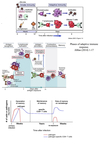Introduction Flashcards
Immune Response
Definition
- Maintain a state of homeostasis such that when the system is perturbed by a foreign invader (external or internal) an adequate response is generated to control the invader
- Then the system returns to equilibrium.
- It’s memory of that particular invader is retained so that a more rapid and heightened response will occur should the invader return

External Threats
- Microorganisms
- Bacteria
- Viruses
- Fungi
- Parasites
- Protozoa
- Worms
- Ectoparasites
- Mechanical or chemical trauma
Internal Threats
- Cancerous cells
- Abnormal cells
- Old or damaged cells
Mechanisms of Defense
- Exterior Barrier
- Innate immune response
- Adaptive immune response
- Memory
- Prevents reinfection or recurrence of illness
- Maintained by adaptive immunity
- Functionally combines both innate and adaptive immunity
Exterior Defense Mechanisms
Provides a natural barrier that:
- Prevents microbial colonization
- Prevents host invasion
Microorganisms generally need to adhere to/penetrate host tissues and proliferate at that time to induce disease.
Mechanical Barriers
Contribute to defense by inhibiting attachment and penetration of infectious agents.
- Skin
- Mucus
- Cilia lining mucosa (mucociliary elevator)
- Mechanical
- Coughing
- Sneezing
- Peristalsis
Chemical Barriers
Numerous components of bodily secretions contain microbicidal factors.
-
Sweat and sebaceous secretions
- Contain lactic acid and fatty acids
-
Lysozyme
- Present in tears, saliva, and nasal secretions
- Hydrolyzes bacterial cell wall
-
Acidic environments
- Urine and vaginal secretions
- Hydrochloric acid in stomach
-
Lactoferrin and transferrin
- Iron chelators
-
Defensins
- In the lung and GI tract
- Damages microbial membranes
Bacterial Interference
- Normal flora colonizes:
- Upper respiratory
- Lower GI
- Reproductive tracts
- Skin
- Competes with pathogens for nutrients and for attachment sites on epithelial or mucosal surfaces
- Potent barrier to the establishment of infection by pathogens
Microbial Invasion
Pathogens can evade, overwhelm, or penetrate a barrier.
After entry into the host it begins to replicate.
Body generates an immune response.

Immune Response
Overview
Innate Immunity
- Ready to function prior to exposure to the threat ⇒ rapid response
- Attempts to control and/or eliminate the threat
- If unable to eliminate the threat, the goal is to keep the body alive long enough for the adaptive response to occur
Adaptive Immunity
- Activated if innate immunity has failed to eliminate the threat
- Threat has bypassed an “activation threshold”
- Includes mechanisms that require days to weeks to become fully functional
- Usually capable of eliminating the threat
- Establishes long-term memory

Innate Immunity
Overview
- Functions by means of pre-existing antimicrobial molecules and cells
- Can resolve most insults
- Only has a few types of recognition molecules that recognize common motifs to many different pathogens
- Can use components of the adaptive immunity to target their immune response
- Antibodies & Cytokines
Innate Immunity
Components
- Phagocytic cells
- Neutrophils
- Macrophages
- Natural killer (NK) cells
- Several cytokines
- Complement
- Multiple plasma proteins
Innate Immune Response
Goals
- Kill/remove the threat
- If unable to remove threat, amplifies and stimulates the immune response
- Prevent spread of the threat
- Prepare for the adaptive immune response
Cytokine
Definition
- A mediator that influences the growth, differentiation, or function of cell types inside and outside of the immune system
- Made by cells of the immune system and other cells in the body
- Usually a soluble glycoprotein that binds to specific receptors to induce signaling
Tissue Macrophages
There are two major types of tissue macrophages:
- Resident macrophages
- Microglia
- Kupffer cells
- Alveolar macrophages
- Osteoclasts
- Proinflammatory macrophages
- Recruited from the blood during an immune response










